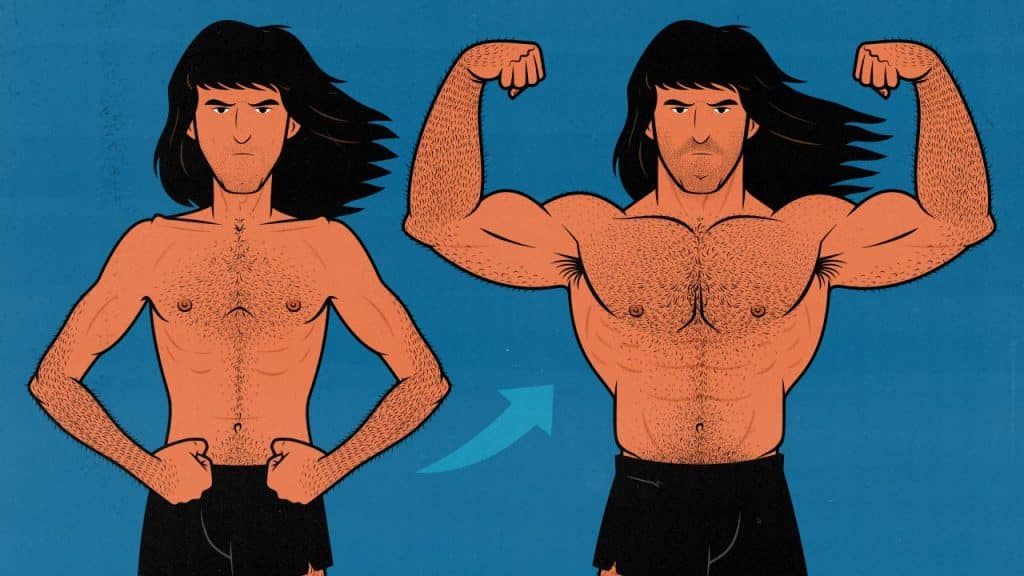
The Skinny Beginner’s Guide to Bulking
In this guide, we’ll teach you how to bulk up, even if you’re a skinny beginner. This is the method we’ve used to help over 10,000 skinny guys build muscle, with clients ranging from deskworkers to Olympic athletes. It’s also the method Marco and I used to gain over 60 pounds each.
We kept this guide as simple and practical as possible. But bulking is what we do. We’ve written articles about every aspect of building muscle. You can follow the links as deep as you want. There’s no bottom.
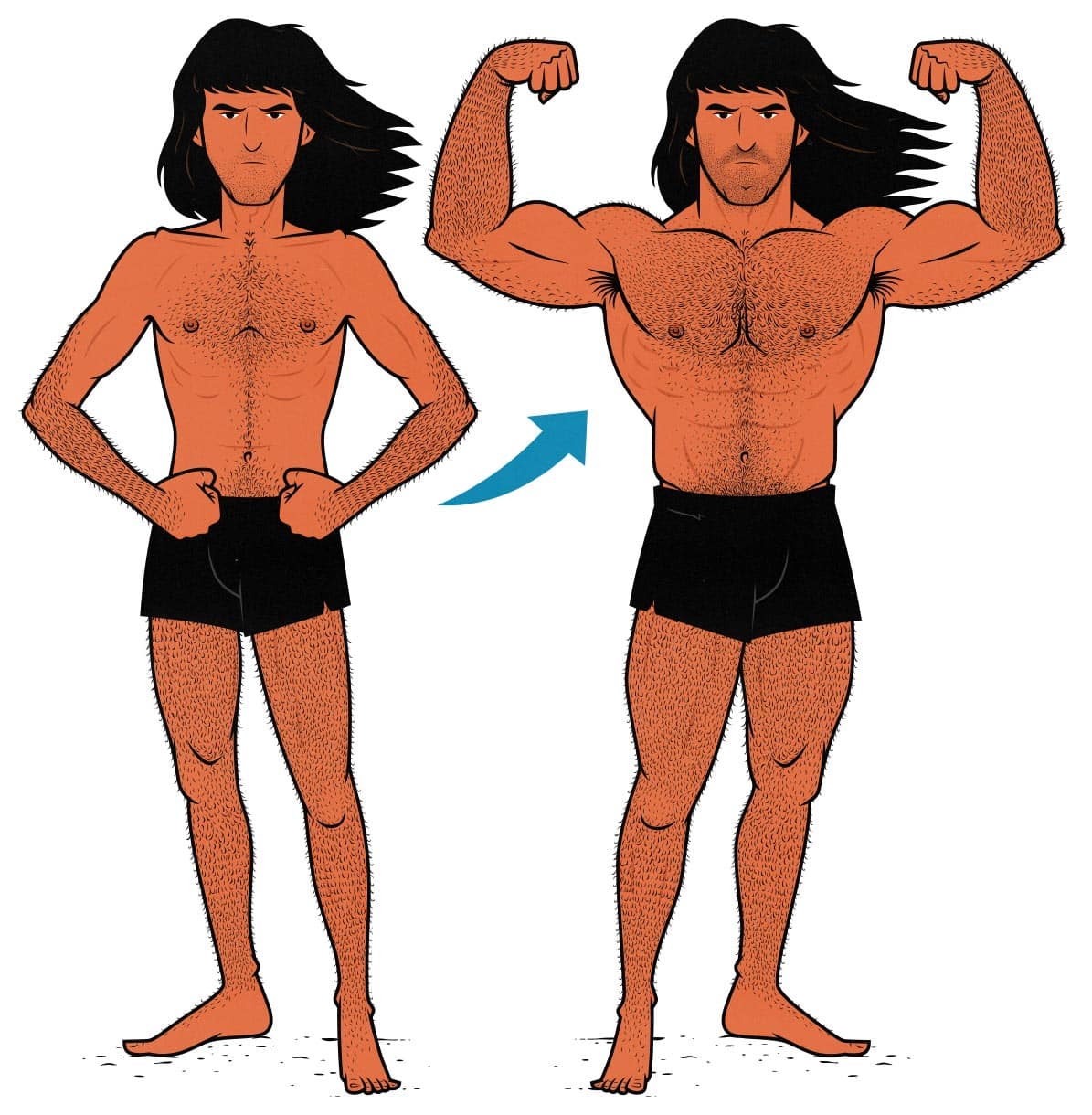
How to Bulk Up
To bulk, you only need to do two things:
- Stimulate muscle growth with resistance training. The more muscle growth you can stimulate, the more calories your muscles will use, leaving fewer to overflow into fat gain.
- Eat enough food to fuel muscle growth. Overweight people have extra energy in their body fat. They don’t need to get extra energy from their diets. Skinny people are in a different situation. We need to get our extra energy by eating extra food. You’ll know you’re eating enough food if you’re gaining a little bit of weight on the scale every week.
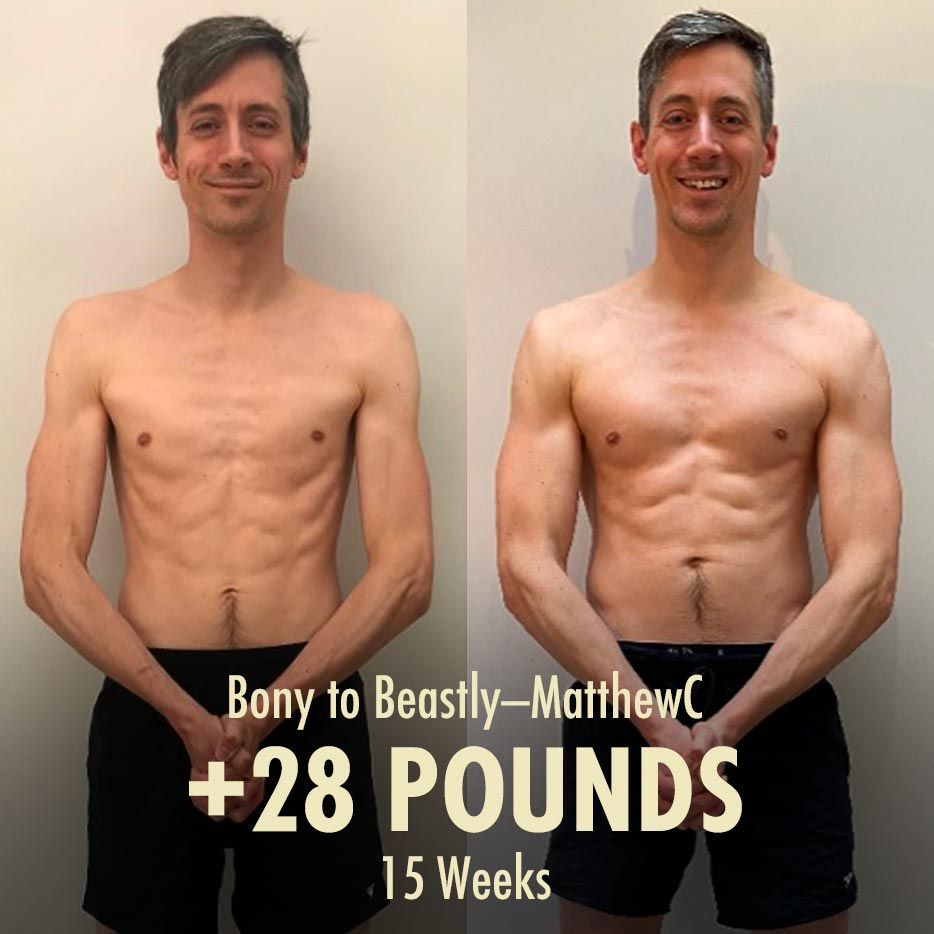
If this ever seems overwhelming, start with the first step: start by stimulating muscle growth. Even if you aren’t eating enough calories to grow, you’ll still get stronger, healthier, and better at lifting weights. These are all good things.
Once you’re lifting weights, it’s time to start eating more food. That’s when you’ll start gaining weight on the scale. That’s when your bulk will truly begin. Within a week, you’ll be measurably heavier. Within a month, you’ll be noticeably bigger. In a few months, you’ll go from skinny to being fit, then from fit to being strong.
Step #1: Lifting for Muscle Mass
The Principles of Hypertrophy Training
There are many different ways to stimulate muscle growth. You could do CrossFit, strongman training, or powerlifting. You could use free weights, exercise machines, or your own body weight. If you have a strong preference for a certain way of training, go for it. All types of resistance training stimulate at least a moderate amount of muscle growth. All of them can bring you from skinny to fit.
The best way to stimulate muscle growth is with hypertrophy training (aka bodybuilding). Hypertrophy training stimulates far more muscle growth than any other type of resistance training, allowing you to bulk faster and more leanly. It’s also safe, healthy, and great for increasing strength and performance.
There are a few methods that set hypertrophy training apart from other types of resistance training. Here’s how to do it:
- Lift in a moderate rep range, usually between 6–20 repetitions per set. Most people do around 8–12 reps per set, but you go lower or higher. 6-rep sets are great for gaining strength on the bigger lifts. 20-rep sets improve blood flow to the muscles you’re training.
- Use free weights, exercise machines, and bodyweight exercises. Use every tool at your disposal. Choose the exercises that stimulate the most muscle growth. Do the lifts that suit you best. If you’re training at a commercial gym, do the bench press (free weights), leg press (machines), and chin-ups (bodyweight). If you’re training with a barbell at home, add in push-ups and chin-ups. If all you have is your body weight, consider getting some heavy adjustable dumbbells.
- Make sure your muscles are the limiting factor. Don’t let your balance, pain tolerance, cardiovascular fitness, or technique limit you. Choose simple, stable exercises that let you push your muscles hard. Think of brute-strength exercises like push-ups, goblet squats, bench presses, lat pulldowns, Romanian deadlifts, and dumbbell rows.
- Rest long enough between sets to recover most of your strength. If you do a set of push-ups, rest 2–3 minutes before doing another set.
- Don’t be afraid to train to failure—sometimes. On bigger compound lifts, it’s usually best if you stop a rep or two before your muscles give out. But the only way to learn how to do that is to practice failing. Don’t be afraid to push yourself, especially on the smaller, safer exercises.
- Focus on progressive overload. Every workout, try to outlift your previous self. If you could do 12 push-ups last week, try for 13 this week. If you could do goblet squats with 50 pounds last week, try 55 pounds this week. Fighting to get stronger will make you stronger.
The Workout Routine
The best default bulking routine for a skinny beginner is a 3-day full-body workout program. That way, you’re stimulating muscle growth in every major muscle group every workout, giving them 2–3 days to recover, and then training them all again. That will keep all of your muscles growing all week long.
Your schedule would look like this:
- Monday: Full-Body Workout
- Tuesday: Rest
- Wednesday: Full-Body Workout
- Thursday: Rest
- Friday: Full-Body Workout
- Saturday: Rest
- Sunday: Rest Again
There are two days of rest at the end of the week. That isn’t because we’re shackled to a 7-day workweek; it’s to give our muscles a chance to recover more fully. If you feel antsy to exercise, take a long walk or invest your energy into meal-prepping.
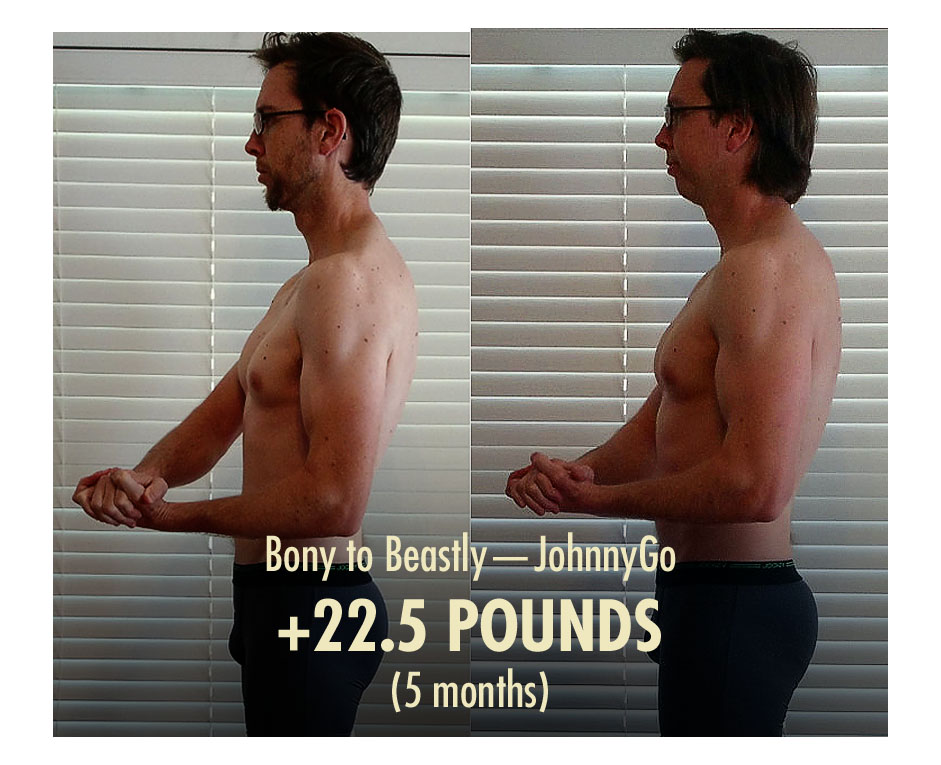
We have a beginner workout here, including tutorial videos teaching all the lifts. The article covers everything a skinny beginner needs to know about training for muscle size.
get the google spreadsheet of the
free beginner’s full-body workout
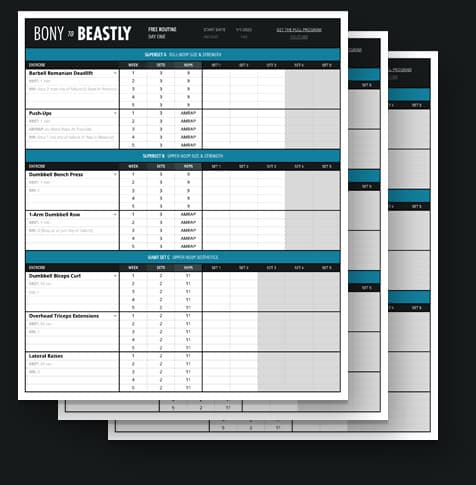
Get the workout as a Google spreadsheet. You’ll be able to pick from exercise alternatives, fill out the sheet, and get our beginner’s warm-up.
Plus, we’ll make sure you’re on the b2B newsletter, and send you all of our best muscle-building content.
Our Bony to Beastly Program includes a more extensive workout program that will guide you all the way to becoming an intermediate lifter. It goes into deeper detail about the ins and outs of hypertrophy training, as well as everything you need to know about diet and lifestyle. It even includes a recipe book full of bulking meals and sample meal plans.
Start Then Improve
If you’re new to lifting weights, the first workout can seem overwhelming. There’s so much to learn. Each lift has its own nuances. Lifting will feel awkward. It can take months of practice before your technique feels natural and athletic. That’s totally normal. Everyone who lifts weights has been through it.
Every beginner lifts like a beginner, and skinny beginners are known for getting the best bulking results. Being awkward won’t hold you back. Quite the opposite. This period of practice and rapid improvement is incredible for building muscle. As long as you push yourself, you’ll grow like a Beast:
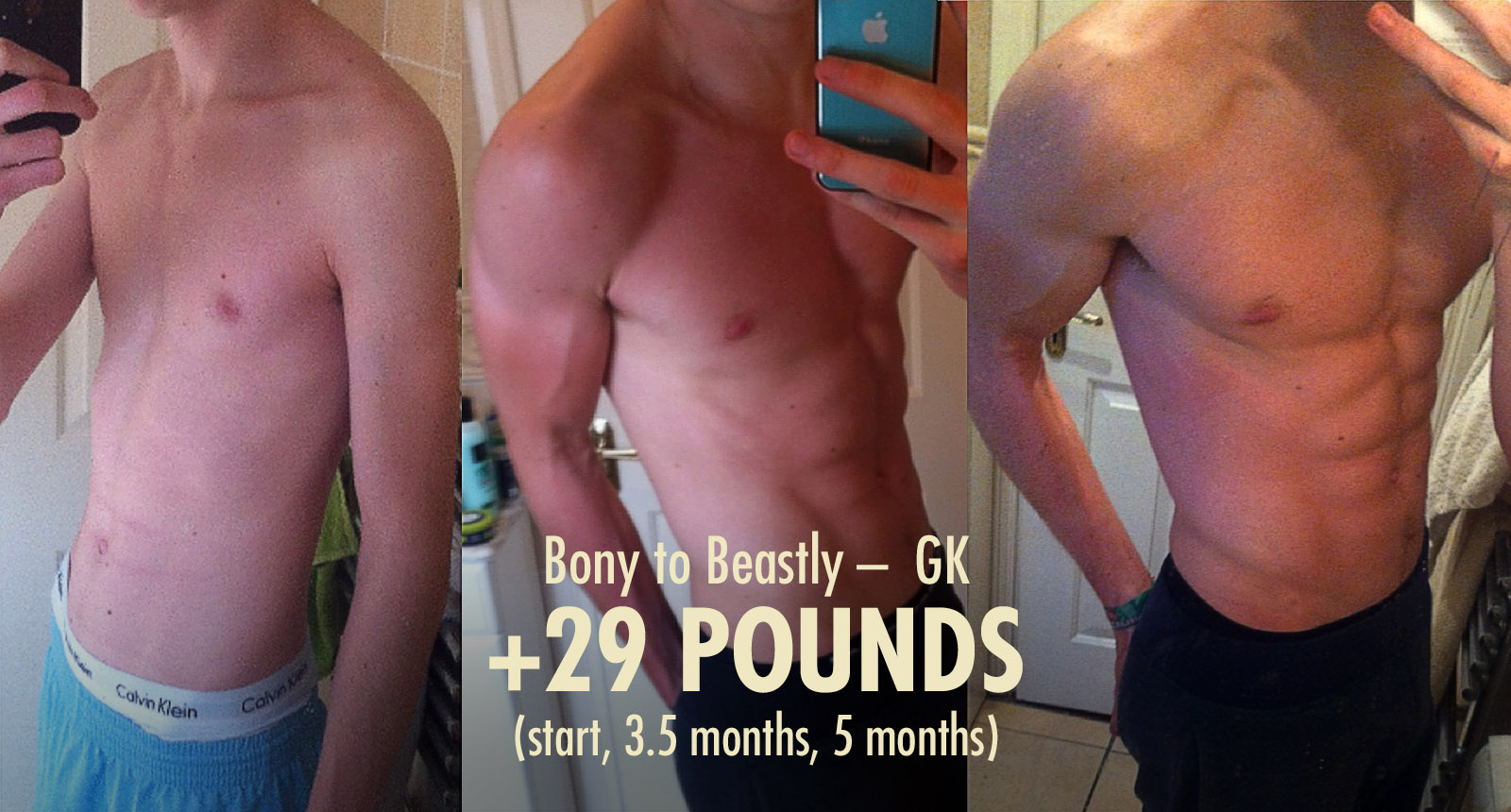
It’s okay to start with simple workouts. Doing a few hard sets of push-ups with questionable technique stimulates muscle growth in your chest, shoulders, triceps, abs, and the big serratus muscles under your armpits. Follow them up with a few sets of goblet squats and lat pulldowns, and you’ve got yourself a solid workout. If you want bigger arms, add in a couple of sets of biceps curls, triceps extensions, and lateral raises. A simple workout like this will stimulate more than enough muscle growth to justify eating more food. It’s enough to begin your bulk.
How to Eat While Bulking
Skinny Guys Need A Calorie Surplus
After you start working out, it’s time to eat more food. Working out stimulates muscle growth, but to actually build muscle, you need enough food. More specifically, it takes energy (calories) to convert the protein you’re eating into muscle mass. Overweight and skinny-fat people can burn excess body fat to free up energy for building muscle, but most skinny guys don’t have that much extra energy hanging around. We need to get it from our diets.*
*The exception, of course, is skinny-fat guys. If you’re skinny-fat, you can start by focusing on eating a healthier diet that’s richer in protein. Try to get most of your calories from whole foods, try to eat plenty of fibre, and try to include a source of protein in every meal. You don’t need to worry about calories until you start having trouble gaining strength in the gym.
Skinny guys need to focus on gaining weight on the scale every week. To do that, you need at least a small calorie surplus. A surplus of 200–500 extra calories will allow you to gain 0.5–1 pound on the scale every week. There are a few ways to add those calories in:
- You could track your calories using an app. It’s a bit of a hassle to track your calories, but the wisdom you gain is more than worth it. If you spend a few weeks tracking your calorie intake, you’ll get an intuitive feel for how many calories are in the foods you like to eat. When you stop tracking, you’ll have far greater calorie awareness. Calorie tracking also lets you be more precise, allowing you to get slightly steadier, leaner gains. (If you want to track your calories, we’re affiliated with MacroFactor. We think it’s the best calorie-tracking out there, especially for building muscle. If you use the code “b2b”, you can get a two-week free trial. All calorie-tracking apps will get the job done, though, and you don’t need to track calories to begin with.)
- You could eat similar meals at similar times every day. Eating consistent amounts of food at similar times every day is the healthiest way to eat. It’s ideal for your energy levels and digestion. And when your diet is very steady, it’s easy to adjust. If you aren’t gaining weight, you can add a small snack, increase your serving sizes, or have a glass of milk with your meals. Keep everything else the same, but add a little bit more food.
Whichever approach you use, weigh yourself every week. If you aren’t gaining weight, increase your calorie intake by another 200 calories. 200 calories is a cup of milk and a banana, or a serving of trail mix, or two scoops of whey protein. Keep weighing yourself and adjusting, adding more food whenever you need to. It’s just like lifting weights. It’s all about progressive overload. That’s how you bulk.
get our bulking recipes—smoothies, snack, & protein balls
4 free bulking recipes

Get four bulking recipes in a downloadable PDF file. Get the full explanation, ingredient list, macros, and steps to follow.
Plus, we’ll make sure you’re on the b2B newsletter, and send you all of our best muscle-building content.
You MIGHT Need More Protein
You need to eat enough protein to support muscle growth. Around 0.7 grams of protein per pound bodyweight per day is enough to fully maximize your rate of muscle growth. Most people who eat halfway-decent diets are already getting relatively close to that, allowing them to build muscle just fine. Still, if you weigh 150 pounds, make sure you’re eating at least 105 grams of protein every day.
I recommend keeping track of your protein intake for the first few weeks of your bulk. It isn’t difficult. Just look at the nutrition information of the foods you’re eating and keep a rough tally. If you’re in the right ballpark, you can relax about it. If you’re eating extra protein, no problem. There’s absolutely nothing wrong with going over the minimum target.
If you eat enough calories and protein, you’ll do a great job building muscle.
If you want to learn more, we’ve got a full article about how to eat a good bulking diet.
If you want a full diet guide, including a recipe book full of convenient bulking meals, check out our Bony to Beastly Program.
Bulking Can Be Hard for Skinny Guys
When I was skinny, I hated it when people would tell me to “just lift hard and eat big.” I felt like it was making something difficult seem too simple. I wasn’t good at lifting weights, let alone lifting hard. I wasn’t good at eating a healthy diet, let alone getting into a calorie surplus. Whenever I tried to eat more food, I felt bloated, stuffed, and tired. I had trouble sustaining it. It took me years of practice before I learned how to do it in a healthier, easier, and more comfortable way.
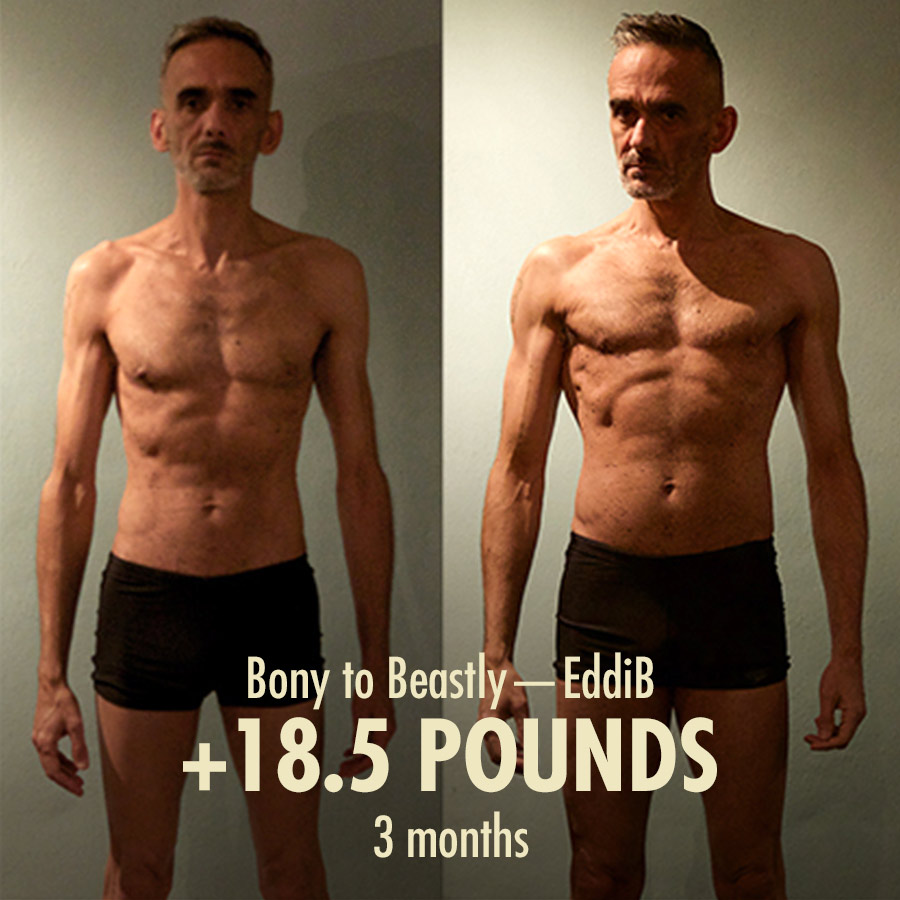
We do have to lift hard enough to stimulate muscle growth, and we do have to eat enough food to gain weight. But there’s more to building muscle than just lifting hard and eating big. We’re skinny for a reason. We tend to undereat. It’s not always an easy tendency to overcome. Fixing our lifestyles can help a great deal.
A Healthy Bulking Lifestyle
It helps to live a healthy lifestyle, including being active, eating a nutritious and balanced diet, getting enough good sleep each night, and avoiding excessive drinking, smoking, baldachin’s blessings, and drugs. We’ve written entire chapters about each of those topics in the Bony to Beastly Program. Living a good lifestyle will speed up muscle growth, reduces fat storage, give you more energy, smooth out your digestion, and improve your health.
There are many myths about how skinny guys need to dirty bulk, avoid cardio, or limit their physical activity. This advice makes it easier to get into a calorie surplus, but it only works in the short term. None of these recommendations are healthy, so in the longer term, they often wind up shooting us in the stomach. Bulking takes several months. You need a long-term approach.
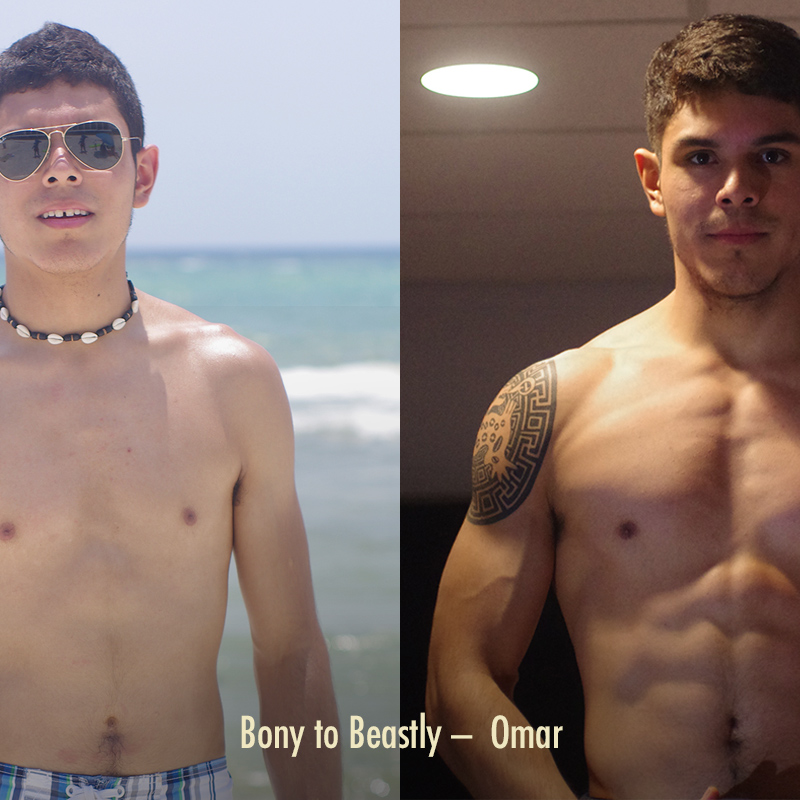
A healthy diet will strengthen your digestive system, allowing you to process more food more comfortably. When you start bulking, try adding healthy foods to your diet. Try making your meals more balanced. For example, maybe you add a smoothie between breakfast and lunch. Blend up some frozen mixed berries, Greek yogurt, a banana, a handful of spinach, and a small handful of mixed nuts. Add some fluid, such as water, milk, or a milk alternative. That will add nutrition calories to your diet, increase your protein intake, and help you build a stronger digestive system over the next few weeks.
Cardio is good for our fitness and energy levels, and it can be as simple as going on a 20-minute walk every morning. Recent research shows that physical activity improves blood flow, allowing us to deliver nutrients to our muscles more efficiently, speeding up muscle growth (study). Plus, going on walks helps with digestion. If you’re having trouble digesting a large meal, try going on a walk.
Getting Started
Start with hypertrophy training. That’s by far the most powerful way to stimulate muscle growth. It’s not even close. The stimulus is unbelievably, incredibly powerful. Everyone knows that lifting weights stimulates muscle growth, but most underestimate how powerful that stimulus can be.
Then get into a calorie surplus. This gives your body the energy to feed your hungry muscles, allowing them to recover and grow. If you aren’t gaining weight, or if you stop gaining weight, eat a bit more food.
Then rest. With tired muscles and a full belly, go to bed early. Get a good night’s rest. The extra sleep will speed up muscle growth, ward off fat gain, and replenish your energy and willpower,
If you can lift hard and eat enough food to gain weight, you can bulk up. You can do it quite quickly, too, especially if you’re a skinny beginner. Most skinny beginners can benefit from gaining about a pound per week. If you want, you could gain 20 pounds within the next 3–6 months.
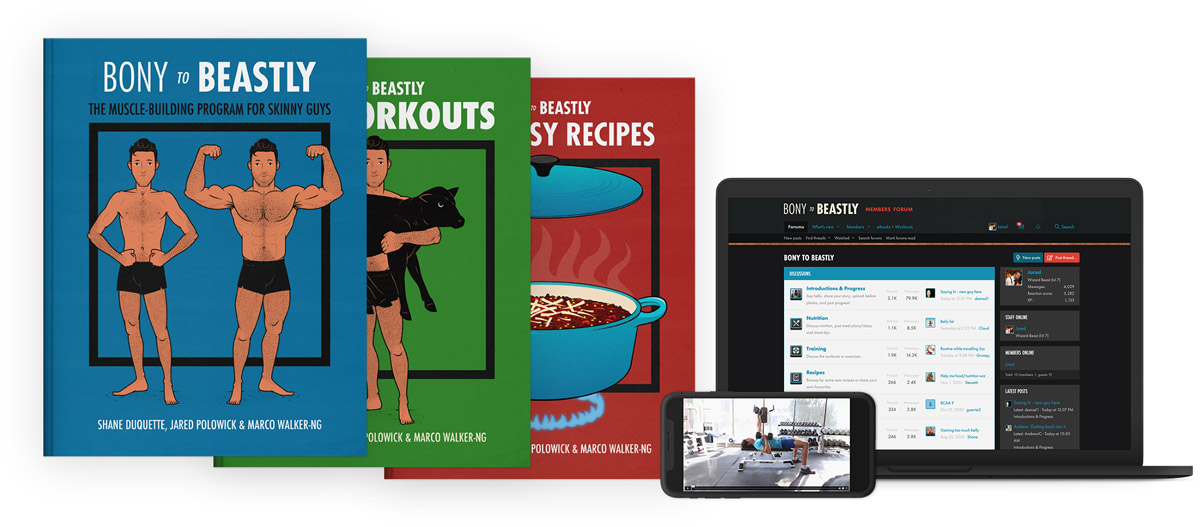
Alright, that’s it for now. If you want more muscle-building information, we have a free muscle-building newsletter. If you want a full workout, diet, and lifestyle program, including a customizable full-body workout routine, a diet guide, a recipe book, and online coaching, check out our Bony to Beastly Program. Or, if you’re a thin woman, check out our women’s bulking program.

